Compression Mold Manufacturing: From Concept to Final Product
Compression molding is a popular manufacturing process used to produce various plastic products. It is a widely used method due to its high production efficiency, cost-effectiveness, and excellent quality. The process is commonly used to manufacture parts with complex shapes, such as automotive components, electrical parts, medical equipment, and consumer goods. In this article, we will take a closer look at compression mold manufacturing, from concept to final product.
What is Compression Mold Manufacturing?
Compression mold manufacturing is a plastic manufacturing process that involves compressing a material in a mold under high pressure and temperature. The process is carried out using a compression molding machine, which applies pressure to the material to create the desired shape.
The compression mold manufacturing process typically involves the following steps:
Step 1: Design and Engineering
The first step in compression mold manufacturing is to design and engineer the mold. This involves developing a mold design that will produce the desired shape and size of the finished product. The mold design should also take into account the materials to be used, the manufacturing process, and any other relevant factors.
Step 2: Material Selection
The next step is to select the appropriate material for the product. The material selected should have the required properties, such as strength, durability, and heat resistance. Some of the materials commonly used in compression mold manufacturing include thermoplastics, thermosets, and elastomers.
Compression mold service Case
See follow Custom Mold RFQ
Good morning Lily.
I have attached the stp files so that you can quote a 4 cavity compression mold per the request below. This would be for the mold only.
We would be requesting a 4-cavity compression mold with a shrinkage factor of 3% per our molded silicone.
Our customer is in a big hurry on this one, so please quote your best lead time. I’m sure you will have questions so please do not hesitate to ask.
Thank you, Lily. I hope you have a great day!
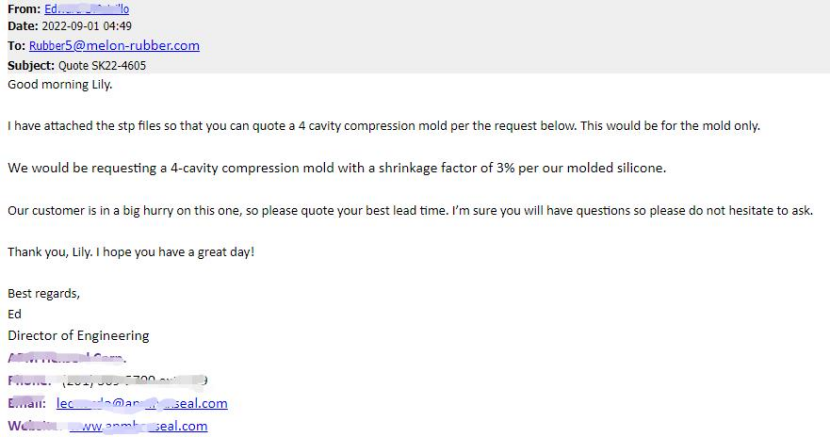
After receiving the project drawings from the customer, our engineering department immediately carried out project analysis.
Good morning, Ed,
As your customer is in a hurry, the mold price follow for reference:
Mold Tyle: compression mold
Mold Material: 718 steel
Cavity Quantity : 4
Export Mold Price: USD 2,200
Mold+Sample Lead Time: 20days after mold design approval
If further discussion, we need to know:
1. Hardness of silicone and product tolerance
2. Surface effect of mold
3. The specification of compression molding machine , or processing video (required mold size?...)
Other possible factors...
Waiting for your reply
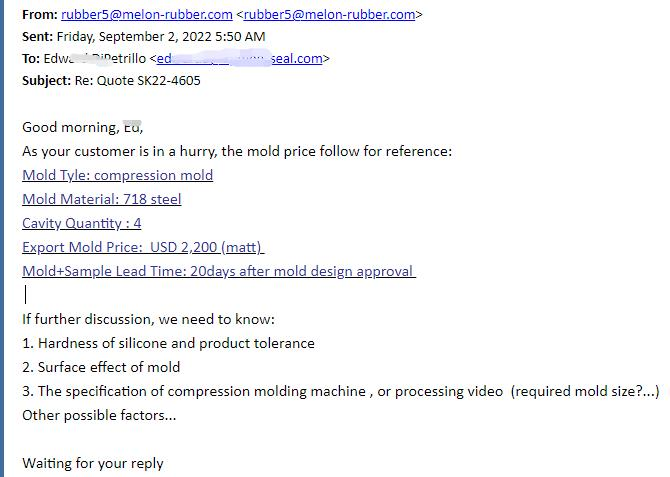
Step 3: Mold Making
After the mold design is finalized and the material selected, the mold is then manufactured. The mold is typically made of metal, such as aluminum or steel. The mold-making process involves machining the mold to the desired shape and size, and then polishing it to ensure a smooth finish.
Step 4: Material Pre-Treatment
Before the material is placed in the mold, it is usually pre-treated to improve its flow characteristics and adhesion to the mold. The pre-treatment process may involve heating the material or adding chemicals to improve its properties.
Step 5: Compression Molding
Once the material is pre-treated, it is placed in the mold and compressed using the compression molding machine. The machine applies high pressure and temperature to the material, causing it to flow and conform to the shape of the mold. The material is then cooled and solidified to form the final product.
Step 6: Post-Processing
After the product is formed, it may undergo post-processing to improve its properties or appearance. This may involve trimming excess material, polishing, painting, or adding surface texture.
That night, we received the details of the customer's requirements for the compression mold
Good Morning Ed,
After our brief meeting this morning, here are the answers needed to get this project started:
1. Hardness of silicone and product tolerance
Hardness would be 50 Durometer, product to meet tolerances per RMA A3.
2. Surface effect of mold
Surface Finish per RMA F1 on part, mold to be polished to a surface finish of 10 micro-inches or better. Part should be free of tool marks, dents, nicks or scratches.
3. The specification of compression molding machine, or processing video (required mold size?...)
Mold to be used in a 50-100 Ton press as direct compression, no pot/plunger. The maximum size would be 11in. L X 11in. W X 9in H and
minimum would be 8in. L X 8in. W X 6in. H for the presses. Mold material to be P20 steel or equivalent (certified).
We will be working on the 2D Detailed Drawing as requested.
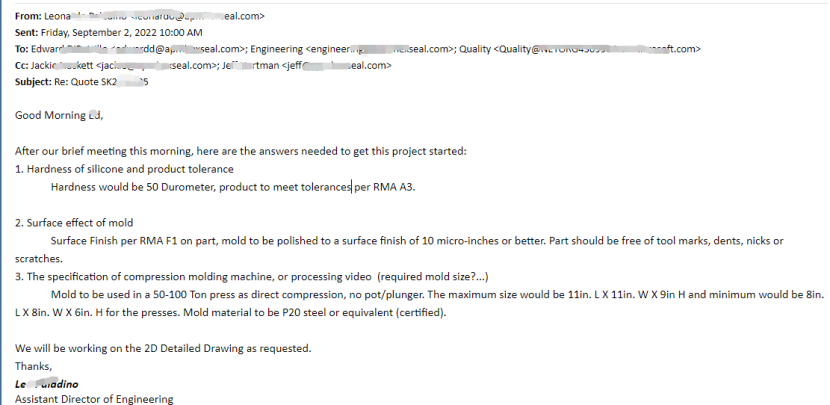 After confirming the details of mold requirements, our mold quotation was also approved. The customer sent us a mold order.
After confirming the details of mold requirements, our mold quotation was also approved. The customer sent us a mold order.
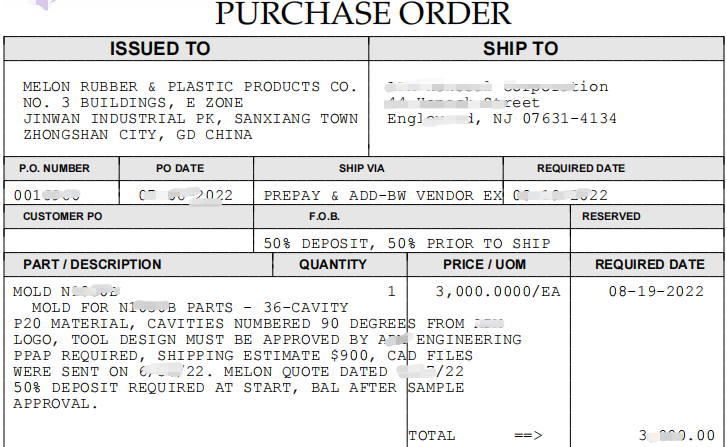
After receiving the order confirmation from the customer, the engineering team immediately started the mold design. Mold design drawings (including 3D drawings and 2D detailed drawings) shall be completed within 36 hours and sent to the customer for confirmation.
Of course,the customer also has some questions about the mold design we provide
Hello Lily,
Here are questions that our Engineering group had after the Design Review of your mold drawings:
- The drawing to base the tool design is 11*01 rev Q. This is the N1030B drawing and was confirmed by APM Engineering. The CAD files have already been sent to you. Please disregard all Q1004 dimensions because there are differences between the Q**4 and the N**30B drawings. Updated drawings were resent on 9/13/22.
- Is Melon factoring any shrink factors for mold dimensions? Our experience shows a slight shrinkage.
- The cavities are machined into one solid plate. Wouldn’t this impair cavity and pin repairs?
- Is there a method used for the insert hex alignment? Do you have recommendations?
- There are 8 guide pin holes, what are all of these used for? Are they for your internal machining process? We did not see any detail on this.
- There seems to be a lot of clearance between the pins and the inserts (.012”). Please explain why.
- Some views show mold handles. Can we get more detail on size and location , so that we can look at potential clearance issues?
- Do you have the ability to make this a hinged mold for ease of opening and closing? Of course any design changes would require a re quote.
- Do you use hydraulics? If so, what features would you add for ease of operation?
- What is the plunger material made of ?
Please address these questions and if you need clarification, please let me know.
We are excited to start on this project with you, and if all goes well we can see this opportunity expanding!
Thanks for all your help Lily.
We provided the customer with a detailed DFM analysis, and more project analysis, final customer agreed to the mold design scheme. We also started mold processing as planned.
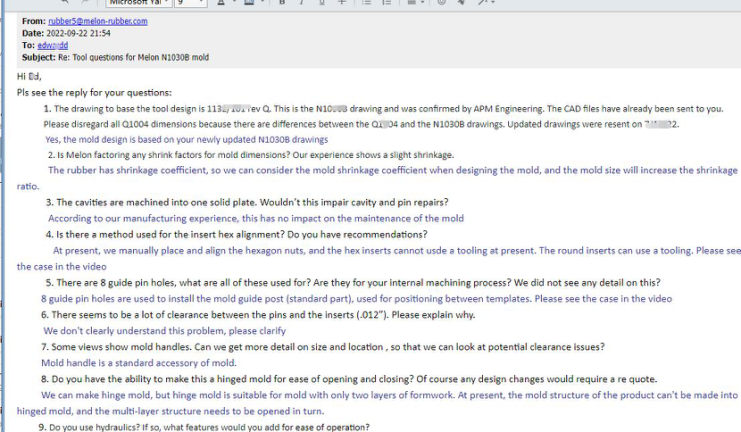
After 15days, The mold and sample are completed and sent to the customer
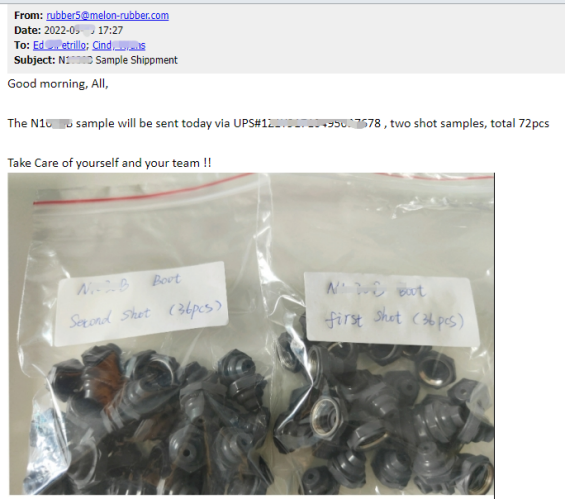
The customer received the sample and tested it. The good news is that the customer reported that all these samples passed the test pressure test, leak proof test and startup test.
Good evening, Lily, how are you?
Yesterday afternoon I followed up on the actuation testing and the parts looked good after 40,000 cycles. This is good news!
I will be entering a PO today for the 5000 pcs of each.
Also, could you tell me the status of the N**30B mold? I know we are getting close!
Thanks Lily, have a great evening.
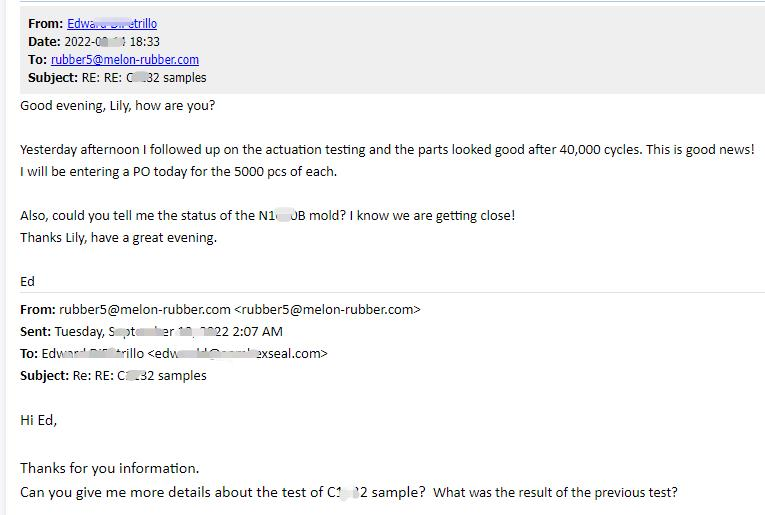
Benefits of Compression Mold Manufacturing
There are several benefits of compression mold manufacturing, including:
High Production Efficiency: Compression molding is a highly efficient manufacturing process that can produce large quantities of products quickly and cost-effectively.
Versatility: Compression molding can be used to produce a wide range of products with complex shapes and sizes, making it a versatile manufacturing method.
High-Quality Products: The compression molding process can produce high-quality products with excellent dimensional stability, strength, and durability.
Cost-Effective: Compression molding is a cost-effective manufacturing method that requires minimal labor and equipment costs.
Environmental Friendliness: Compression molding can be an environmentally friendly manufacturing process, as it generates minimal waste and can use recycled materials.
Need top-quality liquid silicone injection molds for your products? Our experienced team provides comprehensive mold design, fabrication, and production services. Get your customized molds for the automotive and consumer goods industries. Request a quote now!
